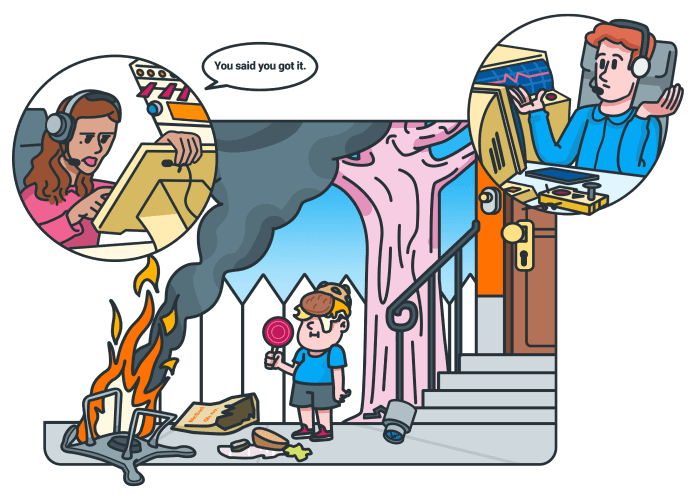How to build trust in the remote workplace
Last updated on: March 1, 2023
A recent Gartner Inc. survey showed that in 2020, an astounding 88% of companies worldwide urged their employees to shift from offices to working from home. And with such a major move, we will need to relearn how to communicate and build trusting relationships, now that we no longer share physical space. Accountability and productivity are expected to suffer.
If CEOs want their businesses to thrive, and we as employees want to keep working to the best of our abilities, we’ll have to make a joint effort of building trust in these new, digital offices. At Clockify, we’ve set out to explore this transformed landscape and find the right tips that will help you create a trusting, connected remote workplace.

Table of Contents
The importance of trust
Without going into too much detail, trust is, naturally, a vital piece in the puzzle for any company owner who wants to succeed. Some would argue that it’s even more important for remote workers, because it is more difficult to attain. Just by building strong, trusting bonds between the employees, managers and the CEO, you gain:
- More content employees;
- Greater productivity;
- Reliability and accountability for one’s workload;
- Less turnover;
- Better quality of work;
- Office dynamics that push the company forward.
And while it is more difficult to build trust when you are in different parts of the world or timezones, that doesn’t mean it’s unattainable. It just requires a little more effort.
The reality of trust in remote workforce
For the purpose of research, we’ve reached out to as many remote workers, managers, and CEOs as possible, to pick their brains on the topic of building trust.
Here is what some of them had to say:
“This may sound silly but I am a mom, and I think it’s given me superpowers. I go with my gut a lot and I like to have a few calls with and other correspondence with my potential employees before hiring them. My team is strong and growing but even our most recent addition has been an incredible asset; as we were chatting it was like talking to a friend, we talked business but the conversation also drifted to personal things and I felt like I had known her for years, she was comfortable opening up to me and usually when conversations go this way I know it’s going to be a good fit. They trust me enough to become transparent with me and I honor them with the same.”
– Laura Like, CEO, lauralike.com
“There is a thin line between tracking progress and micro-managing. I’ve seen many managers confuse one for the other. I was lucky enough to have been mentored by great managers during the early part of my career. Thanks to their inputs, I was able to steer clear from accidental micro-managing. Once tracking progress becomes micro-management, it just backfires the entire equation. It will end up with your co-workers feeling you don’t trust them.”
– Will Ward, CEO, Translation Equipment HQ
“Oftentimes, the methods for building trust, particularly for remote work, are leadership-sided. This can, unfortunately, work in the opposite way. For example, if a team feels like there is a “big brother” always watching, always questioning, it’s going to make employees feel like they are being judged at every turn. Instead, keep lines of communication open – ask questions, listen to concerns and work to make sure the team feels supported, on the same page and unified. A team’s ability to work together is based on trust and communication.”
– Ashley Sterling, Director of Operations, The Loop Marketing
“The move to remote means that the hallway conversations and coffee room interactions are not happening, you can’t easily see all the non-verbal queues that we traditionally got from the office environment. Things like ‘you seem stressed’, ‘you have been locked in the conference room for meetings all day’.
– Tim Lynch, Lynch Insights
Today, we need to look for how our coworkers are doing actively, and that can’t be done in a focused meeting; it isn’t on the agenda. I have found that personally reaching out early or late (depending on how I know the person works) and just checking in on them helps. Please don’t make it a call about a project. Keep it personal, and people will open up.“
“There have been times where I have promised something, like a recommendation on how to deal with a particular issue on a project, by a certain date and then have not been able to deliver on that for whatever reason. In those cases, I’ve made sure to go back to the person expecting the information and explain why I can’t hit the date we agreed on. It’s not always an easy conversation, but at least I’m being open, honest and transparent about the work. I think the worst thing is where the deadlines come and go and no one even bothers to tell you that they are going to miss it, so that’s what I try to avoid.”
– Elizabeth Harring, Director, Girls Guide to Project Management
These are just some responses in a sea of emails we’ve received. But among all of them we’ve seen a few common threads pop up:
- Accountability and reliability
- Communication
- Mentorship, not micromanagement
As remote workers, we need to be able to rely on one another precisely because it’s more difficult. As we are about to see, it takes a lot of determination and effort, but the results are immeasurable.

Difficulties in building trust
Of course, the path to trustworthiness doesn’t come without its own set of hurdles. These three appear to be the most common ones with telecommuters:
- The company is unsure of what method to use to build trust
- Differences in employee personalities
- Work pressures that come from remote work
The company is unsure of what method to use to build trust
John Hill, CEO of Energists shares a recurring problem that he noticed:
“The main mistake I’ve seen made are leaders relying on a sense of camaraderie on the social side to build trust between coworkers, or trying to force this relationship with “fun” team-building exercises. It certainly helps when team members get along, but that’s a different kind of trust.”
Hill goes on to say:
“I think we’ve all had coworkers we trust as friends but don’t necessarily trust in a workplace context for whatever reason. The best way to build trust in a team is to set every member up to succeed and outline clear deadlines, goals, and processes. As the team works together successfully, trust will develop naturally between them.”
Not everyone will respond the same way to the methods you use. Some people find informal socializing with their coworkers a way to build trust. For others, it’s showing up on time and respecting deadlines. Remote workspaces are especially difficult when it comes to finding the right trust-building method.
What you can do is inform yourself as much as possible – read articles, advice from other business owners, but most importantly, ask employees about their opinions. Precisely because we are all different, it’s best they share what they believe is a trustworthy train in a person. Then, find a method that will include them showing those traits.
Some examples:
- Getting a good time tracker to note comings and goings, and practicing transparency;
- Informal video calls as digital “casual Fridays” and online team building;
- Discussing bigger project directions and decisions with employees, etc.
Differences in employee personalities
Just like in a physical office, not everyone will get along. Some people will form good friendships, and some will see their coworkers as simply that. And it’s all perfectly fine. To have people truly trust you, it’s best to respect their wishes and personal boundaries.
An employee doesn’t want to do yoga over Zoom? Don’t make them.
Another says the virtual office is too serious? Discuss organizing some kind of online team building.
Get to know your employees before trying out any kind of trust building strategy. You’ll be able to gauge better what specific trust building strategies will work.
Additionally, have HR always be at their disposal. Even though they don’t have to share the same physical space and it’s easier to ignore each other, conflicting coworkers can put a damper on the overall atmosphere. Not to mention slow down the workflow.
Work pressures that come from remote work
Remote workers are known to have a blurrier line between work and free time. A lot of the time they will work longer hours, or have more haphazards schedules, especially if they work from home. They often feel the pressure of having to work harder to prove themselves, neglecting their private life. This alone is a major contributor to burnout. A lot of managers and CEOs have this misconception that working from home is easier and makes employees more accessible. This is absolutely wrong.
If you want employee’s trust, you should:
- Let them know they have fixed work hours, and practice little to no overtime;
- Be understanding about personal days off;
- Set realistic deadlines.
Now, let’s take a closer look at actual solutions. Following are our tips, based on our correspondents’ answers and research.
Building trust on different levels
Building trust as a teammate/coworker
Take initiative, but be unobtrusive
By taking initiative, we mean starting conversations, asking questions, and making comments when others might back down. If you have a concern about a project or a deadline, and you know others might feel the same way, voice your opinion. However, keep in mind that for some, this kind of action might seem a little too forward if you do it too often. No one likes a showoff, and you don’t want to be seen as a contrarian, or someone who wants to be the boss when the boss isn’t around.
Listen more – be observant
Do your best to learn how to be more observant and aware of your work surroundings. While you are not sharing the same physical space with your coworkers or teammates, you are sharing the digital one. And support is important when we work remote/from home.
Take note of when people are most active in different chats, when they send emails and, for those who really want to get to the nitty-gritty, which coworkers chat the most amongst each other. Because clicks will form naturally, and it’s good information to have when you want to approach some of them informally. It will help you break the ice easier.
Try to be a little casual
Speaking of informal, do your best to be a little casual with your coworkers. We do acknowledge that introversion can be a big hindrance in a workplace, and that people skills shouldn’t necessarily be a requirement for a job position. However, some degree of politeness and informality can help you build trust sooner.
After all, you should be more than just a name and an avatar on someone’s screen. Make yourself stand out from the rest of the office: whether through your hobbies, taste in music or film, or personal life. Because sharing your personality gives more weight to a work relationship, and helps others connect better to you.
Respect others’ boundaries and create your own
We can all agree that there’s nothing more appreciated than when our teammates respect our boundaries. Whether it’s not sending us emails or texts after work, or letting us vent out a frustration over the latest meeting.
If your coworkers have clearly set rules for work communication, respect their choices and schedules no matter what. And if there are none, ask directly. A simple: “Hey, can you tell me if there are any set boundaries you have for work communication?” can go a long way. Or saying: “Hey, if I accidentally overstep any boundaries, feel free to let me know.” will let others know you respect their space and are trustworthy.
Boundaries also means respecting someone’s availability status on chat!
Image source: Microsoft Teams
In much the same way, be open with your own boundaries. Present them as they are: a means to keep your work-life balance, not some draconian laws everyone must follow or else. You don’t want to alienate people by sounding too strict with your time, either.
Be supportive
We often see announcements in group chats: someone got married, had a baby, bought a new car, moved to a new place, etc. And people usually respond with emoticons or write a congratulatory message.
You should be open to doing the same, as good news can be scarce these days. And if possible, send them a direct message and congratulate them one-on-one, or ask for more details (all in good taste, of course). Best case scenario – it sparks up a conversation that leads to a better relationship. Worst case – you sent a slightly more personalized congratulatory message to a coworker. It’s win-win!
Be open to learning and asking questions
There are few better ways to strengthen trust than admitting mistakes and learning from your coworkers. When you are not afraid to show your faults and are open about learning from them, it shows others that you are transparent about your work. How?
If you have a problem finishing a task, and there is someone on your team who could help, you have two options: admitting you’re stuck, despite the initial embarrassment, and asking for help – or – stay quiet thinking you’ll seem incompetent, and try to power through alone. What will most likely happen is that, in the first case, the task will be finished on time with some help, and your coworker will feel more confident about themselves, and at ease about your honesty and openness.
In the second case, you run the risk of pushing back the deadline, doing a sub-par job, and when they find out, your coworkers can label you as someone who is too proud to ask for help at the group’s expense.
Communicate, communicate, communicate
One of our correspondents, Jake Meador from Mobile Text Alerts, had a great example:
“I had a situation at a former job where a coworker and I were just consistently missing each other. So I asked if she had a half hour free during the week so we could talk. In the meeting, I simply asked her if there were things I could do in my job to make her work easier or to better support her in what she was doing. (I was a copywriter and she was a marketing processes manager so we worked closely together.) By simply acknowledging that I may be failing her in some way, it made her feel comfortable to talk honestly. And by the end of the meeting, we realized that both of us had been worried about our own performance and that the other person didn’t have any issue. From that day on, we had a very good working relationship and even something of an office friendship.”
As Meador’s account shows, open communication can go a long way towards building trust. If you have any doubts or issues with your coworkers, it’s best to address them head on, than to live with speculations and assumptions.
Building trust as a team lead/manager
A fair share of the above advice can be applied to team leads/managers, too. The core of building trust rests on verbal communication and body language. And when those channels are obstructed (as with remote work), you need to invest more time and energy to achieve the same effect through digital channels.
Support joint problem-solving
Get people to work on a solution together as soon as a problem arises.
Usually, the first thing they are inclined to do is to find out who is responsible for it, even though oftentimes, knowing that information doesn’t help fix the problem. It will only cause distrust among the group members. So what can you do?
Organize a brainstorming session through a video call, or via chat. Lead the meeting to make sure everyone stays focused on finding a solution, rather than the person who made the mistake. This helps root out the oh-so-common finger pointing. Instead, you get them used to trusting the process and that they can overcome a problem by working together.
💡 To find out more, you can take a look at our article on how to create and promote teamwork in the workplace.
Be timely with everything
As a team lead or manager, your best bet in making team members trust you is to be on time. Whether it’s with meetings, emails, feedback, and so on. If they can count on your punctuality, it opens the door to them trusting in other avenues as well: your overall judgment, decision making,…
There are different time management techniques you can learn and forward to your teams.
Give feedback often and make it constructive
Employees need feedback. It’s what keeps them moving forward, even if they don’t feel up to the task. Remote workers in particular, as they have no way to see you in person, and gauge your reactions to them. More than anyone else, they need the boost to stay productive and happy.
Giving regular feedback builds trust in your presence and fair judgment of their work ethics. What is more, they can trust you will vouch for them when they bring up raises, or have an issue with the work itself.
For example, a team member knows there are records of them being productive and a contributing member of the team with good results. When they hit a rough patch (like getting ill, missing work for an emergency, or simply have a string of bad days that impact their mental health), they can rest assured you will know it’s not them being lazy. Because they trust you and the feedback process to know their work ethic is not misjudged.
Step in only when you have to
Trust also means knowing that employees can autonomously decide what is best for their work process, and having faith in their judgment. This is the part where, in turn, managers and team leads need to build trust with others.
The first step in practicing this is to slowly but surely start relinquishing control. Leave certain low-level decisions up to them, guide them on how to communicate, and let them sort out future problems themselves (unless they require HR mediation). Team members need to work independently. They will notice that you trust them, and will step it up to maintain that trust.
💡 We also extensively discussed the most common issues with virtual team management, and offered advice here:
Accept that there will never be complete trust
Our other correspondent, Vanessa Phan of Cardinal Education had a very insightful point:
“We can embrace the mentality of “trust, but verify.” Trust that your staff has potential, is competent, and is hardworking. Verify that their work, by means of spot checking, editing, and giving feedback, in order to help them improve. It takes time for staff to build their believability and credibility in a company. Otherwise, experience is moot, and we eliminate the essence of mentorship. At every tier, we should have a regular checking system, such as a performance review, in order to concretely discuss progress.”
What we can learn from Phan’s statement is that measuring productivity is also a form of building trust. That is why there is no shame in tracking employee time spent on tasks, or identifying wasted time. Full transparency means trusting that everyone will do their part responsibly. Timesheet app, for example, is a great way to keep team members accountable.
Encourage open communication
FInally, let trust build itself organically by endorsing people to voice their opinions. If they have any doubts in either the tools they use, the work process, feedback, or something completely different, let them speak their mind. How does this help build trust?
For example, you can have an anonymous survey every month, checking employee satisfaction. You can also ask for signed surveys, while ensuring that all of the information coming your way stays confidential.
Of course, you should ask that their opinions and feedback are within reason and constructive, not just straight bashing on the company.
Additionally, one of our email correspondents, RIshav Kanal, CEO of inPerson shared an interesting method employed in his company:
“Virtual working sessions & virtual game nights help build trust and connectivity with remote employees. Our team has 2 virtual working sessions per week where team members can hop on a zoom call and experience the environment of being in the office and being able to roll back in their chair to propose a thought to the group. No agenda is set and the space is given for creative ideas to flow back and forth.”
Building trust as an employer/CEO
Have a stricter hiring process
Consult your HR representative on what sort of method you can use to check a candidate’s trustworthiness. The interview can contain fictional situations (or use ones your company has already been through) and ask what they would do.
Ask for opinions and thoughts as often as possible
Like we’ve mentioned already for managers and team leads, it is vital you ask both them and other employees for feedback. When a CEO keeps pushing their own tempo, it makes others feel like their happiness doesn’t matter. People need to be heard, and their feedback implemented, if you want them to trust not just you, but the company as a whole.
Without that kind of trust, turnover and general dissatisfaction are more likely. Not to mention that it’s easier for remote employees to engage in more private conversations where they can express their distrust and support each other in possibly leaving the company.
Provide reliable and intuitive workplace tools
Anton Konopilov, the CEO of Palma Violets Loans had this to say when we asked about building trust:
“I know my team is reliable because I manage them well. Making sure that your team is equipped with digital systems needed for remote work will ensure the efficacy of the team.
Good management is one of the key methods to create a trustworthy atmosphere. To prove good leadership, equip them with top-notch tools that will make their work easier. Just some of them include:
- A feature-packed employees hours tracker to help them stay accountable and productive;
- A customer relationship management tool for your sales and marketing team;
- HR platforms, to give your HR department access to more information, and your employees a place to get to know each other, etc.
Of course, it goes without saying that it’s best to find tools that are affordable, but not completely free. Employees notice when a CEO is taking advantage of free platforms, and oftentimes the free plans aren’t scalable for larger companies, which only makes their jobs difficult. Stinginess also breeds distrust. It forms an opinion that you don’t really care about helping your employees do a better job.
Use performance plans
Employee performance plans can show you’re interested in employee progress, instead of considering them expendable. We live at an age where fear of expendability grows stronger by the day. Technology keeps reminding us that we can all become easily replaced and our job made obsolete.
Similarly to constructive feedback, regularly conducted performance plans benefits both you and the employees. They know you are present and keep their improvement in mind, while you get more information on how well they perform, and where you can contribute (by providing online seminars, courses, mentorships, etc).
We have some practical advice on crafting performance plans and how to make them work:
- Everything about performance improvement plans
- Develop a team performance plan in four steps (plus templates)
In conclusion
Trusting one another is no easy feat in personal life, let alone at work, when our livelihood and career reputation are on the line. However, practicing open communication, showing vulnerability, care, and the willingness to admit mistakes and publicly learn from them already goes a long way. As we’ve seen, trust is more than delivering tasks on time, especially remotely, when you see your coworkers through their profile pictures and words on a screen. Learning about each other, helping and knowing we are a part of something larger than us is bound to overcome any physical distance.





